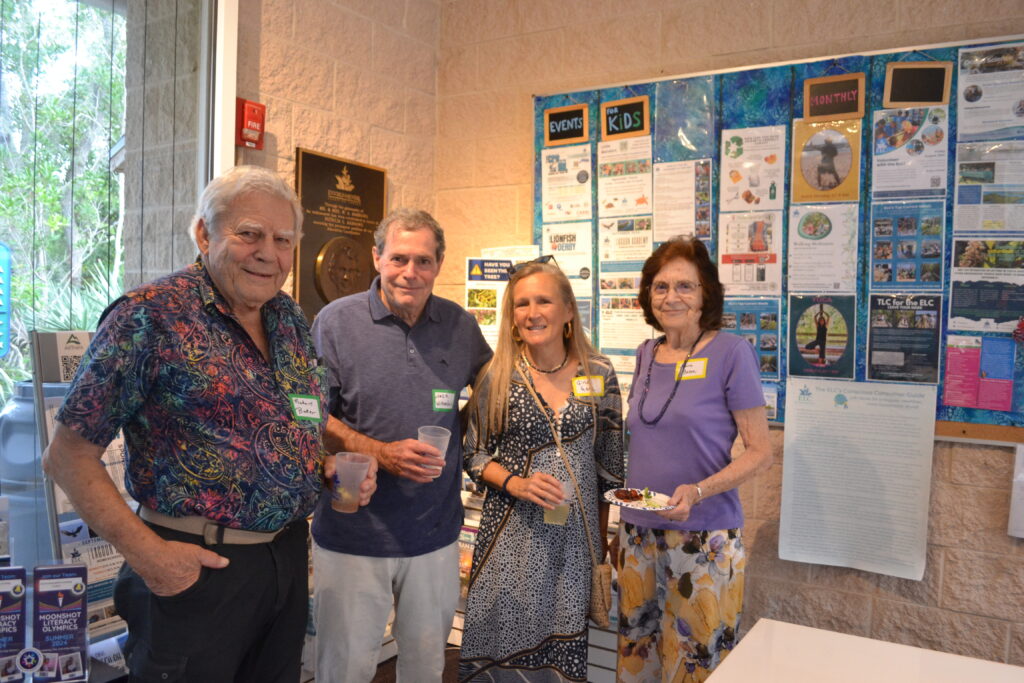The prescience of Environmental Learning Center founders decades ago is even more notable today, at a time when Florida’s governor is pushing to develop golf courses and other amenities on pristine state parklands.
Fortunately for us, in 1986, ELC founders George Bunnell, Maggy Bowman and other environmentalists had the foresight to preserve a 65-acre area of land in the center of the lagoon and create a conservational campus, where children and adults can learn about nature and ways to protect it for the benefit of humans, plants and animals alike.
At a reception to celebrate the ELC’s 36th anniversary, guests milled about the campus enjoying refreshments while perusing the Clyde Butcher: Living Waters exhibition of black and white photography. The exhibit is on loan through Sept. 25 from the Florida Aquatic Preserve and Friends of Spoil Islands, its fundraising arm.
Early ELC supporters reminisced about its creation, including Richard Baker, Pelican Island Audubon Society board chairman. He noted that PIAS originally held the 99-year lease on the county-owned land before the ELC became its own nonprofit.
“Audubon was then, and still is, concerned about kids not knowing much about the environment. It’s gotten worse, because most kids are only out 15 minutes a day and that’s probably waiting for the school bus,” said Baker.
In her welcome to everyone, Barbara Schlitt Ford, ELC executive director, said our quality of life here is unique.
“I was born here, my father was born here, I raised my children here and I love this community. This Environmental Learning Center sits here in this very special spot right in the middle of our Indian River Lagoon,” said Ford.
“We are at the heart of education, teaching about conservation, and we feel we are at the heart of our community. This space is a common ground for all of us. I don’t care your age, your beliefs, where you were born, this is the place for all of us to come together. Nature is the equalizer among us all, because we can agree that our quality of life would be less with a less healthy world around us.”
Ford said they are seeking those willing to temporarily provide guidance, feedback and suggestions for the future, and added that there is always a need for volunteers.
Next up, the ELC is hosting an inaugural ‘CPR for the IRL’ – a monthlong Catch-Photo-Release Inshore Fishing Tournament in conjunction with a Lionfish Derby.
“We had a break between summer camps and the season, and it just timed up with the mullet run,” said Kyle Lacey, ELC finance and HR manager, event co-chair with Heidi Leone Royals, philanthropy director.
“The mullet run is a multi-bait fish that migrates down the coast, so we timed it from Sept. 13 to Oct. 13 to capture that window. All the proceeds benefit our educational programs and conservation efforts.”
The three CPR divisions – junior, conventional and fly fishing – will target snook, redfish, trout and tarpon caught along the 156 miles of the lagoon between the Jupiter and Ponce inlets.
The statewide Lionfish Derby goal is to harvest as many of the tasty but devastatingly invasive species as possible during that same period.
The tournaments conclude with a Heartbeat Celebration at 4 p.m. Oct. 13, at the ELC, with live music, refreshments and awards.
The ELC Nature Inspired Art series of exhibitions continues in October with the Pelican Island Conservation Society Bird and Nature Art Show, and November and December will feature works by Sebastian Art Club members.
In January and February, the Gallery at Windsor lends a photographic exhibit of Florida native wildflowers by Roger Hammer, with sale proceeds split between the ELC and Windsor Charities. And in February and March, there will be an exhibit of artworks by John’s Island residents.
And finally, on March 1, the ELC’s biggest fundraiser, Mangroves, Moonlight and Mykonos, will have a Greek theme.
For more information, visit DiscoverELC.org.
Photos by Kerry Firth

